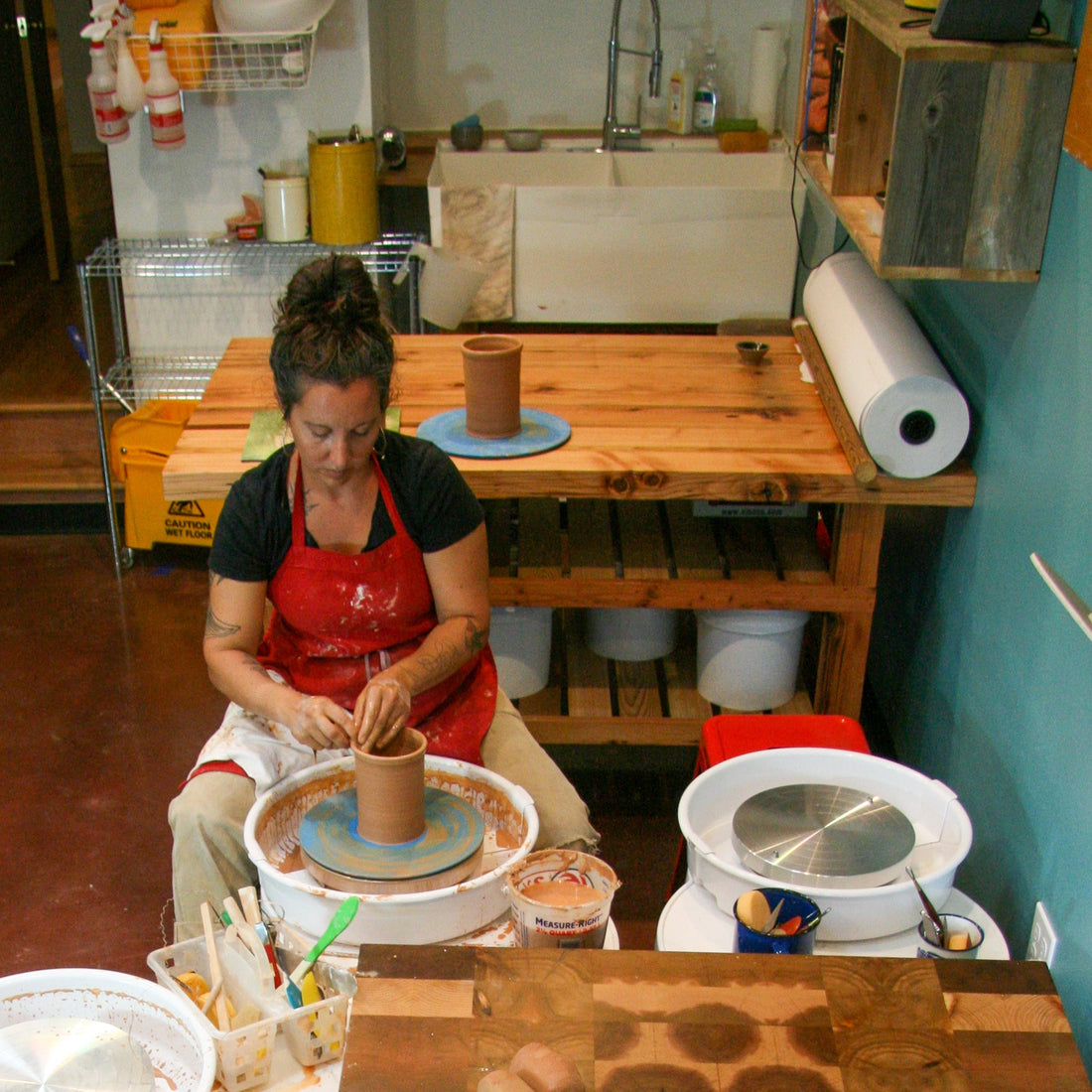UPDATE: Sarah is teaching a workshop on Monday, December 5th, 2022 about setting up your own home studio. She'll be addressing all the information that's not covered in this blog post, and answering everyone's questions. If you're in Seattle, take a look!
 You’ve been taking classes for a while and you love it. So much, in fact, that you’re starting to think about setting up a little studio or workspace in that spare bedroom/garage/basement/shed/un-used corner/closet. Congratulations!
You’ve been taking classes for a while and you love it. So much, in fact, that you’re starting to think about setting up a little studio or workspace in that spare bedroom/garage/basement/shed/un-used corner/closet. Congratulations!
One of the most common questions I get from students at this stage is how to set up a home workspace for clay, and in this series of blog posts I will talk about what to consider when setting up a new pottery studio–including safety, systems, equipment, and scale.
But before we dive in to the advice, start by asking yourself: “what kind of work do I want to make in this space?”
Will you be pinching and coiling? Working with soft or leather-hard slabs? Throwing on a potter’s wheel? Do you want to make large or small work? Are you hoping to start producing work to sell?
The answers to these questions will have a huge impact on the amount of space you will need, the type of mess you will make, and the equipment you will eventually need.
Location Matters
The first thing to consider is where you will set up your space. This is going to have implications for all of the rest of your decisions.
Clay is messy and can be pretty dusty–just ask my partner, who does a lot of the sweeping and dusting at our house. So you will want an area with a mop-able floor that you can separate or close off from the rest of your living space if possible. If you live in a house with a garage or basement those are obvious places to start: most garages and many basements are separate from the rest of the house and have a hard (often concrete) floor.
Another option might be a backyard storage or garden shed. Sheds have the benefit of keeping the mess even farther from your house, but (unlike a garage or basement) many will not have electricity or plumbing which will present other challenges.
If you live in an apartment, you may need to be more creative – do you have a spare bedroom or a decently large closet?
Regardless of the space you manage to carve out for yourself, the following are what I consider to be the most important considerations for any space:
- The Floor: the best possible floor will be hard, impervious, and durable. You will want to be able to make a mess and mop it up without worrying about scratches and dents from clay and dropped tools. My first choice is polished concrete or linoleum. Wood or tile will work but will need some babying. If your only available space has carpet that you need to keep clean, consider laying down upholstery vinyl like this or click together flooring like this to protect your floors and make them easier to clean.
- Electricity: I cannot think of a workspace that won’t need at least electricity for lighting, and most spaces will need outlets for tools like a stick blender, a heat gun, a drill, a Dremel tool, or a pottery wheel. You should consider the layout of your outlets and the quantity and quality of your lighting. You should have outlets and adequate lighting near each of your workstations. While it can be tempting to use power strips and extension cords, you want to be careful not to over extend your available power or create tripping hazards.
- Heat: Many of the spaces that might be otherwise great pottery studios have little or no heat, so you will want to factor a small space heater or other potential heat source into your plans. Space heaters are thirsty electricity users, so you should be able to plug it into its own outlet. I will cover kilns and electrical needs for kilns in a separate post.
- Separation from your living area: even in the best and cleanest circumstances, working with clay is dirty and dusty. If you intend to have your studio in your house (like I do), you should take measures to keep the dust out of the rest of your house. A door between your studio and the house is a good first step. If you aren’t able to have a door, a tension rod and shower curtain can be a helpful (and non-damaging) alternative. I also suggest installing an air filter like this one that is designed for a wood shop. A lot of dust can get tracked back and forth on your feet, and these sticky mats that are designed for construction and remodeling are great for that.
- Plumbing: in my opinion, this is one of the hardest space/systems challenges to resolve. If there is not already a sink in the space you intend to use, having a plumber install one can be quite costly. Most clay work requires at least some water, and having convenient access to water can make cleaning up MUCH easier. That said, after you use the water, it has to go somewhere, and water that is heavy with clay sediment or contaminated with glaze chemicals can’t just be dumped down the drain. I will discuss managing waste water in a later post on studio systems.
- Storage: It’s easy to focus on the space you need to be creative, and that is important... but in every studio I have had so far, storage space was my biggest limiting factor. You will need space to store wet work in progress, work that is waiting to be fired, bisqueware that needs to be glazed, finished work, shipping materials or other packaging if you plan on selling your work, clay, quantities of glaze sufficient for your preferred application method, and a little extra space for all of the other gear that you aren’t even thinking about right now.

separate space, moppable concrete floor, sink, outlets, check!
In addition to all of these space-specific considerations, you will also want to think about tools, furniture, equipment, sourcing materials, health/safety, and community/support. I will cover all of these topics in future posts and link to them here after they are published to make finding them easier. In the meantime, happy making!

